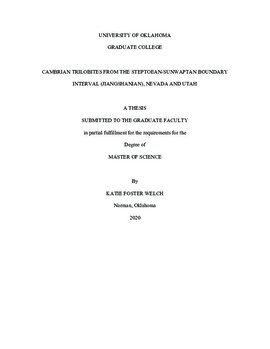| dc.contributor.advisor | Westrop, Stephen | |
| dc.contributor.author | Welch, Katie | |
| dc.date.accessioned | 2020-10-23T14:34:55Z | |
| dc.date.available | 2020-10-23T14:34:55Z | |
| dc.date.issued | 2020-12 | |
| dc.identifier.uri | https://hdl.handle.net/11244/325624 | |
| dc.description.abstract | This thesis documents previously unknown latest Steptoean (Elvinia Zone) trilobite faunas from Nevada and Utah, including their geological context. Samples from Nevada are from the Barton Canyon Member of the Windfall Formation in the Cherry Creek and North Egan ranges of White Pine County. The sample from Utah was collected from the Sneakover Member of the Orr Formation in the northern House Range of Millard County. At both study sites, lithologies are dominantly bioturbated lime wackestone with cm-thick packstone layers, and record deposition under subtidal conditions on a carbonate ramp; sites in Nevada represent a deeper, more distal setting than the site in Utah. The samples yielded trilobite sclerites from 10 species and 15 genera. Labiocephalus cassia is the type species of a new genus, and Anechocephalus ralphi and Noelaspis primitiva are new species. The faunas are assigned to a new latest Sunwaptan Labiocephalus cassia Zone that can be correlated with successions in central Oklahoma and southern British Columbia. The base of the zone is marked by the lowest occurrence of A. ralphi and L. cassia. The faunas provide a glimpse of the paleoecology of an interval that immediately precedes a major trilobite extinction event at the base of the Sunwaptan Stage (base of the Irvingella major Zone). As such, they provide a baseline for understanding the impact of the extinction on the faunas in the region. The faunas comprise two biofacies. The Pterocephalia-Iddingsia Biofacies is from the more proximal ramp settings in Utah. It is dominated by the eponymous genera and has a diversity of nine species. The more distal Labiostria-Anechocephalus Biofacies in Nevada has slightly lower diversity (eight species). New carbon isotope data from Nevada record a positive excursion of δ13C that begins near the onset of the extinction event at the top of the Barton Canyon Member, and rises to peak of 2.17‰ in the lower part of the overlying Catlin Member. A similar positive excursion is expressed in new data from central Oklahoma, although it begins a little higher in the succession, at the top of the I. major Zone. The general pattern is consistent with published reports of positive excursions of δ13C associated with the extinction in Utah and Wyoming, which have been interpreted as the result of increased carbon burial due to upwelling of anoxic water, possibly in response to a sea level rise. These changes may have been at least partly responsible for triggering the extinction. | en_US |
| dc.subject | Cambrian trilobites | en_US |
| dc.subject | Steptoean-Sunwaptan boundary interval | en_US |
| dc.subject | Jiangshanian | en_US |
| dc.subject | Great Basin trilobites | en_US |
| dc.subject | Carbon isotope curves | en_US |
| dc.subject | trilobite extinction | en_US |
| dc.subject | pre-extinction trilobite fauna | en_US |
| dc.title | Cambrian trilobites from the Steptoean–Sunwaptan boundary interval (Jiangshanian), Nevada and Utah | en_US |
| dc.contributor.committeeMember | Cifelli, Richard | |
| dc.contributor.committeeMember | Lupia, Richard | |
| dc.date.manuscript | 2020-10-21 | |
| dc.thesis.degree | Master of Science | en_US |
| ou.group | Mewbourne College of Earth and Energy::School of Geosciences | en_US |
| shareok.orcid | https://orcid.org/0000-0002-0720-3842 | en_US |
| shareok.nativefileaccess | restricted | en_US |
